5.1.1: Inputs and Outputs
- Page ID
- 36024
\( \newcommand{\vecs}[1]{\overset { \scriptstyle \rightharpoonup} {\mathbf{#1}} } \)
\( \newcommand{\vecd}[1]{\overset{-\!-\!\rightharpoonup}{\vphantom{a}\smash {#1}}} \)
\( \newcommand{\id}{\mathrm{id}}\) \( \newcommand{\Span}{\mathrm{span}}\)
( \newcommand{\kernel}{\mathrm{null}\,}\) \( \newcommand{\range}{\mathrm{range}\,}\)
\( \newcommand{\RealPart}{\mathrm{Re}}\) \( \newcommand{\ImaginaryPart}{\mathrm{Im}}\)
\( \newcommand{\Argument}{\mathrm{Arg}}\) \( \newcommand{\norm}[1]{\| #1 \|}\)
\( \newcommand{\inner}[2]{\langle #1, #2 \rangle}\)
\( \newcommand{\Span}{\mathrm{span}}\)
\( \newcommand{\id}{\mathrm{id}}\)
\( \newcommand{\Span}{\mathrm{span}}\)
\( \newcommand{\kernel}{\mathrm{null}\,}\)
\( \newcommand{\range}{\mathrm{range}\,}\)
\( \newcommand{\RealPart}{\mathrm{Re}}\)
\( \newcommand{\ImaginaryPart}{\mathrm{Im}}\)
\( \newcommand{\Argument}{\mathrm{Arg}}\)
\( \newcommand{\norm}[1]{\| #1 \|}\)
\( \newcommand{\inner}[2]{\langle #1, #2 \rangle}\)
\( \newcommand{\Span}{\mathrm{span}}\) \( \newcommand{\AA}{\unicode[.8,0]{x212B}}\)
\( \newcommand{\vectorA}[1]{\vec{#1}} % arrow\)
\( \newcommand{\vectorAt}[1]{\vec{\text{#1}}} % arrow\)
\( \newcommand{\vectorB}[1]{\overset { \scriptstyle \rightharpoonup} {\mathbf{#1}} } \)
\( \newcommand{\vectorC}[1]{\textbf{#1}} \)
\( \newcommand{\vectorD}[1]{\overrightarrow{#1}} \)
\( \newcommand{\vectorDt}[1]{\overrightarrow{\text{#1}}} \)
\( \newcommand{\vectE}[1]{\overset{-\!-\!\rightharpoonup}{\vphantom{a}\smash{\mathbf {#1}}}} \)
\( \newcommand{\vecs}[1]{\overset { \scriptstyle \rightharpoonup} {\mathbf{#1}} } \)
\( \newcommand{\vecd}[1]{\overset{-\!-\!\rightharpoonup}{\vphantom{a}\smash {#1}}} \)
\(\newcommand{\avec}{\mathbf a}\) \(\newcommand{\bvec}{\mathbf b}\) \(\newcommand{\cvec}{\mathbf c}\) \(\newcommand{\dvec}{\mathbf d}\) \(\newcommand{\dtil}{\widetilde{\mathbf d}}\) \(\newcommand{\evec}{\mathbf e}\) \(\newcommand{\fvec}{\mathbf f}\) \(\newcommand{\nvec}{\mathbf n}\) \(\newcommand{\pvec}{\mathbf p}\) \(\newcommand{\qvec}{\mathbf q}\) \(\newcommand{\svec}{\mathbf s}\) \(\newcommand{\tvec}{\mathbf t}\) \(\newcommand{\uvec}{\mathbf u}\) \(\newcommand{\vvec}{\mathbf v}\) \(\newcommand{\wvec}{\mathbf w}\) \(\newcommand{\xvec}{\mathbf x}\) \(\newcommand{\yvec}{\mathbf y}\) \(\newcommand{\zvec}{\mathbf z}\) \(\newcommand{\rvec}{\mathbf r}\) \(\newcommand{\mvec}{\mathbf m}\) \(\newcommand{\zerovec}{\mathbf 0}\) \(\newcommand{\onevec}{\mathbf 1}\) \(\newcommand{\real}{\mathbb R}\) \(\newcommand{\twovec}[2]{\left[\begin{array}{r}#1 \\ #2 \end{array}\right]}\) \(\newcommand{\ctwovec}[2]{\left[\begin{array}{c}#1 \\ #2 \end{array}\right]}\) \(\newcommand{\threevec}[3]{\left[\begin{array}{r}#1 \\ #2 \\ #3 \end{array}\right]}\) \(\newcommand{\cthreevec}[3]{\left[\begin{array}{c}#1 \\ #2 \\ #3 \end{array}\right]}\) \(\newcommand{\fourvec}[4]{\left[\begin{array}{r}#1 \\ #2 \\ #3 \\ #4 \end{array}\right]}\) \(\newcommand{\cfourvec}[4]{\left[\begin{array}{c}#1 \\ #2 \\ #3 \\ #4 \end{array}\right]}\) \(\newcommand{\fivevec}[5]{\left[\begin{array}{r}#1 \\ #2 \\ #3 \\ #4 \\ #5 \\ \end{array}\right]}\) \(\newcommand{\cfivevec}[5]{\left[\begin{array}{c}#1 \\ #2 \\ #3 \\ #4 \\ #5 \\ \end{array}\right]}\) \(\newcommand{\mattwo}[4]{\left[\begin{array}{rr}#1 \amp #2 \\ #3 \amp #4 \\ \end{array}\right]}\) \(\newcommand{\laspan}[1]{\text{Span}\{#1\}}\) \(\newcommand{\bcal}{\cal B}\) \(\newcommand{\ccal}{\cal C}\) \(\newcommand{\scal}{\cal S}\) \(\newcommand{\wcal}{\cal W}\) \(\newcommand{\ecal}{\cal E}\) \(\newcommand{\coords}[2]{\left\{#1\right\}_{#2}}\) \(\newcommand{\gray}[1]{\color{gray}{#1}}\) \(\newcommand{\lgray}[1]{\color{lightgray}{#1}}\) \(\newcommand{\rank}{\operatorname{rank}}\) \(\newcommand{\row}{\text{Row}}\) \(\newcommand{\col}{\text{Col}}\) \(\renewcommand{\row}{\text{Row}}\) \(\newcommand{\nul}{\text{Nul}}\) \(\newcommand{\var}{\text{Var}}\) \(\newcommand{\corr}{\text{corr}}\) \(\newcommand{\len}[1]{\left|#1\right|}\) \(\newcommand{\bbar}{\overline{\bvec}}\) \(\newcommand{\bhat}{\widehat{\bvec}}\) \(\newcommand{\bperp}{\bvec^\perp}\) \(\newcommand{\xhat}{\widehat{\xvec}}\) \(\newcommand{\vhat}{\widehat{\vvec}}\) \(\newcommand{\uhat}{\widehat{\uvec}}\) \(\newcommand{\what}{\widehat{\wvec}}\) \(\newcommand{\Sighat}{\widehat{\Sigma}}\) \(\newcommand{\lt}{<}\) \(\newcommand{\gt}{>}\) \(\newcommand{\amp}{&}\) \(\definecolor{fillinmathshade}{gray}{0.9}\)Lesson
Let's make some rules.
Exercise \(\PageIndex{1}\): Dividing by 0
Study the statements carefully.
- \(12\div 3=4\) because \(12=4\cdot 3\)
- \(6\div 0=x\) because \(6=x\cdot 0\)
What value can be used in place of \(x\) to create true statements? Explain your reasoning.
Exercise \(\PageIndex{2}\): Guess My Rule
Try to figure out what's happening in the “black box.”
Note: You must hit enter or return before you click GO.
Are you ready for more?
If you have a rule, you can apply it several times in a row and look for patterns. For example, if your rule was "add 1" and you started with the number 5, then by applying that rule over and over again you would get 6, then 7, then 8, etc., forming an obvious pattern.
Try this for the rules in this activity. That is, start with the number 5 and apply each of the rules a few times. Do you notice any patterns? What if you start with a different starting number?
Exercise \(\PageIndex{3}\): Making Tables
For each input-output rule, fill in the table with the outputs that go with a given input. Add two more input-output pairs to the table.
1.
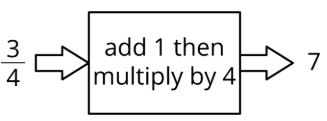
| input | output |
|---|---|
| \(\frac{3}{4}\) | \(7\) |
| \(2.35\) | |
| \(42\) | |
2.
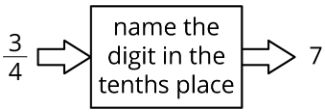
| input | output |
|---|---|
| \(\frac{3}{4}\) | \(7\) |
| \(2.35\) | |
| \(42\) | |
3.
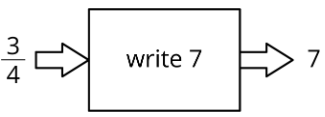
| input | output |
|---|---|
| \(\frac{3}{4}\) | \(7\) |
| \(2.35\) | |
| \(42\) | |
Pause here until your teacher directs you to the last rule.
4.

| input | output |
|---|---|
| \(\frac{3}{7}\) | \(\frac{7}{3}\) |
| \(1\) | |
| \(0\) | |
Summary

An input-output rule is a rule that takes an allowable input and uses it to determine an output. For example, the following diagram represents the rule that takes any number as an input, then adds 1, multiplies by 4, and gives the resulting number as an output.
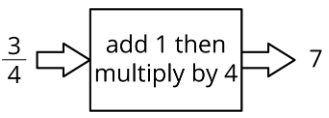
In some cases, not all inputs are allowable, and the rule must specify which inputs will work. For example, this rule is fine when the input is 2:

But if the input is -3, we would need to evaluate \(6\div 0\) to get the output.
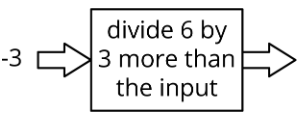
So, when we say that the rule is “divide 6 by 3 more than the input,” we also have to say that -3 is not allowed as an input.
Practice
Exercise \(\PageIndex{4}\)
Given the rule:
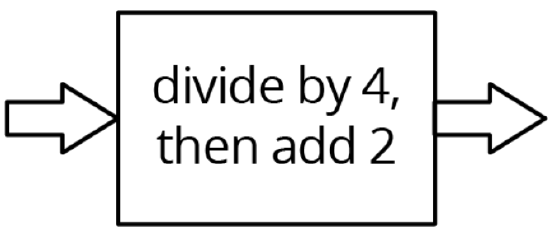
Complete the table for the function rule for the following input values:
| input | 0 | 2 | 4 | 6 | 8 | 10 |
|---|---|---|---|---|---|---|
| output |
Exercise \(\PageIndex{5}\)
Here is an input-output rule:
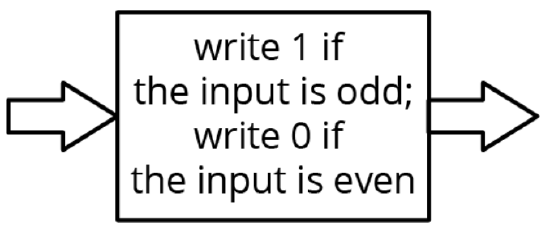
Complete the table for the input-output rule:
| input | -3 | -2 | -1 | 0 | 1 | 2 | 3 |
|---|---|---|---|---|---|---|---|
| output |
Exercise \(\PageIndex{6}\)
Andre’s school orders some new supplies for the chemistry lab. The online store shows a pack of 10 test tubes costs $4 less than a set of nested beakers. In order to fully equip the lab, the school orders 12 sets of beakers and 8 packs of test tubes.
- Write an equation that shows the cost of a pack of test tubes, \(t\), in terms of the cost of a set of beakers, \(b\).
- The school office receives a bill for the supplies in the amount of $348. Write an equation with \(t\) and \(b\) that describes this situation.
- Since \(t\) is in terms of \(b\) from the first equation, this expression can be substituted into the second equation where \(t\) appears. Write an equation that shows this substitution.
- Solve the equation for \(b\).
- How much did the school pay for a set of beakers? For a pack of test tubes?
(From Unit 4.3.6)
Exercise \(\PageIndex{7}\)
Solve:
\[\left\{\begin{array}{l}{y=x-4}\\{y=6x-10}\end{array}\right.\nonumber\]
Exercise \(\PageIndex{8}\)
For what value of \(x\) do the expressions \(2x+3\) and \(3x-6\) have the same value?
(From Unit 4.2.8)


